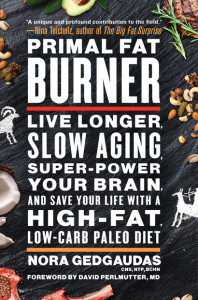
I was interviewed on Hay House Radio by my good friend Heather Dane. We talked about blood sugar and brain health. (Plus a whole lot more!)
Episode recap:
How you see the world, how your mind works, your moods, your cravings…all of these things depend on your blood sugar. So what are the implications for gut health and mental health? Neurofeedback expert and Nutritional Consultant, Nora Gedgaudas, reveals how to balance your body and brain with key nutrition and lifestyle shifts.
You can listen to the episode if you’re a Hay House Wisdom Community member.
Check out this link for how to access the episode and watch the FREE Facebook after show!
Top 9 Steps for Balancing Your Blood Sugar, Improving Your Mood and Brain Health
#1 – Eat Good Fat
The food industry bamboozled us when they influenced researchers to produce studies blaming fat for cholesterol problems and weight gain. Dr. Paul Dudley Whit (personal physician to President Eisenhower), author of the first medical textbook on coronary heart disease, watched coronary thrombosis go from obscurity in 1911 to one of the leading causes of death by the 1950’s. In his observation, it wasn’t the consumption of animal protein or healthy fats creating the problem. He felt that the only thing that had changed in this time was the increase in dietary sugar and “bad” fats (refined vegetable oils).
As new research comes in, we are now realizing that our brains – one of the most important organs for quality of life – run on fat. More importantly, your body and brain are inseparable, so your body also runs on fat!
Some of the best fats are from organic, grass or pasture fed animals, like duck fat, chicken schmaltz, lard, beef tallow, buffalo tallow, or grass-fed, organic cultured ghee. Extra virgin olive oil and coconut oil are wonderful as well and are unrefined. For other plant fats, look for “unrefined” on the label.
#2 – Avoid Bad Fats
This includes refined fats, like trans-fats and refined oils, like vegetable oil, corn oil, and canola oil or any oil that is labeled “refined.”. It also includes fats from factory farmed conventional animals and GMO (genetically modified organism) plants. These are the damaging fats that harm the liver, body and brain.
#3 – Avoid Sugar
Sugar and carbs are instigators of insulin production and glycation, thereby reducing longevity. Nora feels that sugar consumption in any quantity causes damage and dysregulation in the body. This includes white, refined sugar, high fructose corn syrup, artificial sweeteners, agave (which is worse than high fructose corn syrup!), and even less refined sweeteners like honey, maple syrup, and fruit. According to Nora, the fructose in fruit is 20 – 30 times more glycating (damaging to your body) than glucose by itself. If you want some occasional fruit, some berries can be a good option.
#4 – Avoid Carbs (Including Grains, Legumes and Starchy Vegetables)
There is no established dietary need for utilizable carbohydrates (any carb that isn’t fiber). We can use proteins and fats to produce all of the nutrients the body needs that could come from utilizable carbohydrates. While some experts feel that we need carbohydrates to produce serotonin (the feel good/happiness hormone) and melatonin (the sleep hormone), Nora suggests that it’s not required for serotonin. If you are relying on carbohydrates to jack up serotonin (which it can, temporarily), the carbohydrates are giving your brain nothing for the manufacture of it’s healthy structure. Grain-and legume-heavy diets ultimately don’t support serotonin production because they tend to be tryptophan-poor diets.
#5 – Go Organic
Organically grown foods allow us to avoid toxic glyphosate, an herbicide that is potentially carcinogenic and strips the body of it’s important minerals.
#6 – Heal Leaky Gut
When your gut is leaky, an inflammatory response is created in the body, which recruits the immune system. This can become a vicious cycle leading to immune problems, fatigue, and problems with anxiety, depression, brain fog, and memory challenges. Bone broth is incredible for helping your gut heal.
#7 – Consume Organic Grass/Pasture Fed Animal Protein
Avoid factory farmed, conventional animals, which are inhumanely raised, injected with antibiotics and hormones, and don’t even eat their native diets (their diet is often GMO foods that aren’t meant for their digestive system). When studies show that animal protein causes health issues, they are usually talking about factory farmed conventional animals. Instead, choose humanely raised animals who are out on grass or pasture, eating their native diet and not being injected with antibiotics or hormones.
Instead of expensive and popular muscle meats (e.g., ribeye, breast) – which are actually less nutritious, choose the cheaper cuts, like shank, legs and thighs. These meats have more nutrients and allow you to eat more nose to tail, reducing waste.
One of the most nutritious parts of the animal are the organ meats, like the liver, heart and kidney. Organ meats have vitamin C and all of the B vitamins and minerals that your body needs.
#8 – Reconsider Statins
Cholesterol is not “bad.” When cholesterol shows up in the body, it’s there to help put out the fire of inflammation. It also supports the body’s mineral balance and is essential for your brain health and moods. A great metaphor is that cholesterol is like firemen coming to put out the fire of inflammation in your body. It’s not that we want to get rid of the firemen. We want to find out what’s causing inflammation and work at that level (the root cause). Statins have been found to be damaging to brain health, while offering little value to helping the body heal.
#9 – Crush Cravings by Turning Your Body Into A Primal Fat Burner!
The more your body gets used to using fat as a source of fuel, the less you’ll find yourself needing to snack. You may find that you have less cravings and that you can sleep easily through the night, without waking up due to low blood sugar. The key is consistency. The more you can stick to healthy fats as a primary source of calories, the more you teach your body to use efficient logs to fuel the fire, rather than quick-burning and inefficient kindling.
So What’s On Your Plate?
A great meal might include a good portion of green, leafy vegetables, a small portion of animal protein and some healthy fats, like organic extra virgin olive oil, coconut oil, or better yet, my favorite, duck fat!
Click here to learn more about my Primal Restoration® Certification program!





thank you for all the good information you post.
I have been following these principles for 3 years now and feel the best I ever have. Just had a long discussion with my GP on why I will not take statins! He wasn’t happy but its my body!
Thank you once again Nora. I have read and re read your primal fat burner book. I have now found out through some blood tests that I have stageb2 CKD. Any suggestions. I live in England (Yorkshire) in the country I am really well after following all of your advice from the book and also Dr. Perlmutter who introduced me to you.
Thanks again Nora
Jan
Dear Jan,
I sincerely appreciate your kind comments and I’m glad (and not surprised) you have found my book extremely helpful.
For you, so much depends on what the underlying cause of the CKD is. Do you have a history of having been diabetic or pre diabetic? Were you ever diagnosed with a renal polycystic condition? Have you done Cyrex testing (specifically, the array 5 test) to rule out the possibility of autoimmune involvement (and yes—this is available in the UK)? It’s very important to understand how the condition developed to best know how to more effectively address it.
That said…
A fat-based ketogenic approach (a.k.a., ‘Primalgenic™’ ) such as the one I advocate has definitely shown evidence in the literature of benefiting renal health and should be enormously supportive of anyone having kidney disease. From a foundational standpoint this definitely offers the most effective starting place. Mind you, in the early stages of adopting this way of eating there tends to be fluid and electrolyte loss (including potassium and magnesium) that must be compensated for until your body fully effectively adapts to full-time fat burning. You must be especially mindful of this. Maintaining good potassium and magnesium levels, along with strict protein moderation and added hydration, are extremely important for you and should be foremost on your mind while adopting this way of eating. In fact, you might want to find a healthcare provider willing to give you a series of Myers cocktails (an IV solution containing electrolytes, water-soluble nutrients and added magnesium, along with potentially other useful things like glutathione), which could be helpful in terms of rapidly improving electrolyte balance and intracellular magnesium levels. Maintaining a strict adherence to a diet of uncompromising quality and avoidance of compromising dietary and environmental exposures, along with a daily eye to detoxification is also extremely important. It might also pay for you to get 23-and-Me genetic testing to determine whether you have any MTHFR polymorphisms, which could additionally color your capacity to detoxify. It would be good to know (and work to compensate for, as needed). You might also want to look up a product known as ‘FlorEssence’, which is an herbal concentrate (made by Flora, Inc) designed as an extremely powerful, but gentle detoxifier. It’s unique properties allow for more effective detoxification through the best available avenues of elimination. I have personally known two cases of those with renal failure who felt completely turned around (and literally whose lives were saved) using this “tea”. I cannot prescribe it for you, but I can tell you that if it were me I would be drinking it daily. Beyond that, nuancing the approach to match your specific needs is where you need to go from there in order to optimize the benefits. I hope this all makes sense and helps.
Warmly,
~Nora
Hi Nora, love your book Primal Body, Primal Mind. Please can you tell me why legumes are considered bad on a Paleo diet? I’m confused because legumes form a huge part of the Mediterranean diet and the diets of people living in the ‘Blue Zones’. I tolerate legumes very well and am reluctant to stop eating them!
Thanks
Jan
Dear Jan—first off, thanks for your kind words! They mean a lot to me. As for why I don’t promote the consumption of legumes…That amounts to a laundry list of potential problems. I’ll try to be succinct. Just because there are people in Blue Zones eating them doesn’t mean that legumes are somehow an elixir of youth (just as an aside, I went to high school with Dan Buettner, btw). Apart from the socially embarrassing effects they commonly generate, for starters, legumes are predominantly a starch-based food, and nowhere near compatible with aspirations for a primary fat-burning metabolism. But that’s just for starters. In the wild, legumes are all notoriously toxic and inedible. A millennia or two of hybridization has made them more edible, but “more edible” does not make them anywhere near optimally nourishing. All of our efforts at plant hybridization have certainly lessened their dangerous toxicity– but by no means are they entirely benign. Numerous toxic compounds continue to remain in modern-day cultivated varieties of legumes and may represent a significant dietary compromise to human health when consumed in significant amounts (and yes, I have oodles of citations, but no room for all that in this response). Vegetarians and dietitians alike enjoy lauding the presence of minerals such as zinc, calcium, magnesium and iron in legumes. Unfortunately, the other side of this coin is that these minerals, although certainly potentially present to varying degrees (depending on the health of the soil they were grown in) are by-in-large quite poorly bio-available due to the presence of compounds such as phytates, saponins, tannins and mineral-binding fiber. Not only this, but these very substances have the potential to actually deplete your own mineral stores if you eat enough of them! Legumes are in fact especially rich in phytates (also known as phytic acid). This substance effectively binds minerals in a way that makes them extremely difficult to absorb. Distinct deficiencies, in particular can become particularly pronounced in those eating a diet high in whole grains and legumes— with soy by far having the most phytic acid content. Legumes are also known to contain significant amounts of thyroid-compromising substances known as goitrogens. In fact, these substances are high enough in soy to generate concern for not only women’s hormonal health, but also for developing fetuses during pregnancy. Elderly persons may also be especially susceptible. Legumes are also common sources of food sensitivities and are common potential triggers for inflammation and even autoimmunity.
Yet another problematic compound found in legumes known as saponins can damage your gut and even your blood cells when exposed to them. Saponns additionally bind dietary minerals and interfere with protein digestion. All legumes such as beans, peas, lentils, peanuts and soybeans contain concentrated levels of foreign lectins (inflammatory, immune and hormone dysregulating compounds that can also damage your gut—and even your brain). Although lectins of varying types are also present in many foods other than legumes and grains, the ones present in these particular plant foods tend to present uniquely problematic effects for us.
One particularly nasty lectin, called phytohemagglutinin, or PHA, is found in all varieties of beans (including black beans, kidney beans, pinto beans, navy beans, etc.) within the Phaseolus vulgaris species. It is an extremely toxic lectin with damaging cumulative effects. In short, the more PHA you eat the less healthy you become. Cooking can help lessen the concentrations of PHA and other anti-nutrients in some legumes but that doesn’t eliminate all of it. Soy by far contains the most. Legumes contain small amounts of poorly utilized, incomplete protein that is without doubt nutritionally inferior to naturally complete and otherwise highly bioavailable, nutrient dense animal source protein. Legumes are nearly devoid in critical amino acids, methionine and cysteine, which are essential for our health and normal internal protein synthesis. Starchy foods tend to be quite poor in their elicitation of gastric hydrochloric acid— not only essential for the digestion of protein but also for the ionization and assimilation of minerals. And since zinc is needed also for the very manufacture of hydrochloric acid and zinc tends to be depleted by legume consumption, this is an issue that only tends to be compounded with time. The presence of pancreatic protease inhibitors in legumes (and grains) complicate the digestion and bio-availability of their proteins even further, having the potential to even affect the health of the pancreas over time. There is not a single nutrient present in legumes (or grains, for that matter) that cannot be found abundantly elsewhere in a quality, Primalgenic, grain, legume-free diet; and with far fewer potential consequences. There is literally nothing present in legumes that is “essential” to anyone, but there is quite a bit in them that can cause you some real problems.
Just as with you, there are those that seemingly tolerate legumes better than others, but that doesn’t make them optimally nourishing or any sort of health food for anyone.
If you simply love them and feel like you can’t live without them, then treat them like some people treat cheesecake: an occasional “treat”, with no harbored illusions that you are somehow adding beneficially to your health.
Dear Nora, I had a few questions about your response regarding legumes, specifically lentils. Could traditional cooking methods (soaking etc) effectively remove or reduce phytates and other lectins in lentils? Secondly, animal proteins contain high levels of methionine, and I have a homozygous MTHFR gene mutation that raises my homocysteine levels when I eat methionine containing foods ( even though I take the necessary B vitamins). So eating lentils like my ancestors did ( I am originally from India) would seem like a good solution for me since they give me protein without the high methionine – what do you think? Thanks in advance Devika
Dear Devika—
I just want to be clear that I am not here to be the food police and tell everyone what they can or can’t eat if they really want to eat it. Everyone is wherever they are at with their willingness to adopt dietary changes. I am also not here to judge. That said, in answering your question, I can tell you that I can, too am homozygous for MTHFR. I manage to maintain healthy homocysteine levels in spite of this, and in spite of the fact that the majority of my protein comes from meat. If you understand my work you know that I am not advocating for a high-protein diet at all. I always recommend strict protein moderation (unless you happen to be pregnant or lactating). That means that the goal is supplying what is needed with respect to protein/amino acids, but not exceeding that. I’ll spare you the reasons why for now, but the details are amply available in my books and elsewhere on my website if you want to delve into the “why’s” further.
Soaking legumes overnight and extensive cooking helps somewhat with certain anti-nutrients in some legumes and grains… But it cannot eliminate them. That said, though cooking sometimes helps, some lectins are actually made stronger, such as red kidney beans, which become 5 times more toxic when heated to 80 degrees Celsius (nobody anywhere should be eating red kidney beans). And dry heating (as in baking) may not work at all. Pressure cooking tends to work best. If you try to ferment the lentils, this is better for reducing lectin content, but much worse for creating inflammatory histamine, so it can be a trade-off. Lectins are basically low-level toxins in many plant-based— as well as some animal-based foods, by the way. Not all are equally harmful, and the kinds we have been consuming as a species for the longest period of time are the ones to which humans appear to be the most tolerant. The ones that humans are overwhelmingly the least tolerant to tend to be highest in grains and legumes. The animal source foods containing lectins to which humans are the most poorly adapted include dairy products. Lentils contain a lectin known as Lens culinaris agglutinin. This lectin has also been linked to hepatocellular carcinomas (known by immunologists as an Alpha-fetoprotein). These lectins are present in lentils at a level of @513 to 617 hau/g. That isn’t as bad a lectin level as in some other legumes, but certainly enough if your immune system is predisposed to react to them in some way. I’m just saying. If, by some chance you have any immune reactivity to these lectins, or if you are already compromised with, say, mineral deficiencies, etc., that could be enough to be a problem.
You mentioned that your “ancestors” ate lentils. These kinds of ancestral arguments aren’t really that helpful, since as a human species (the kind of ancestry I mostly refer to, as opposed to simply ethnic ancestry) no one ate these foods in any meaningful way prior to 10,000 years ago. If your ethnic ancestors consumed these for a few thousand years, that doesn’t mean it was necessarily enough time to become genetically adapted to eating them. Genetic adaptations to major dietary changes in a population frequently take much, much longer than that. There are rare exceptions to this, such as the development of adult lactase enzymes in certain long-standing dairy-eating populations (and these rare examples get overplayed by those trying to rationalize the consumption of post-agricultural foods). Southern Indians have been eating grains and legumes for a very, very long time. They also have the shortest life expectancy of any people group in the world (save certain indigenous/aboriginal populations eating a modernized diet). Obviously the veganism doesn’t help. I’m just saying. And there is significant evidence in the immunologic literature to suggest that humans are becoming less adapted to many of these post-agricultural foods as time goes on, and not more adapted as one might otherwise reasonably expect. There are many reasons for this that I won’t go into here. But again, I am not telling you what to do.
Lentils only contain about 35% utilizable starch, but depending on how much is eaten that could still be enough to derail ketosis–if ketogenic adaptation is your goal, that is. Also, if you are 100% healthy and not overweight, or struggling with things like heart disease, diabetes, autoimmunity of any kind, arthritis, cystitis or a leaky gut you are trying to heal… Then you “may” be able to get away with eating some of that. May. A person can technically take glucosamine as a means of helping to bind dietary lectins… But frankly I wouldn’t want to have to take that with every meal.
Although the reasons for avoiding legumes go beyond the potential for immune reactivity, this is by far the biggest concern. If you want to settle that score for yourself, I recommend you find a practitioner able to order you Cyrex Labs testing and ask them for the complete Array 10 test. This should answer your question for you in a more definitive manner. If you are non-immune reactive to the lectins in lentils, and not wedded to the idea of maximizing/optimizing your state of ketogenic adaptation, then you can maybe get away with it. Personally, I will pass on the lentils.
Dear Nora,
Thank you for your prompt and very comprehensive reply – I love how you look at so many aspects of an issue. It made me realize that my knowledge is very incomplete, even though I have read hundreds of books on nutrition. I am presently reading Primal Fat Burner, and since I am overweight, have hypertension and coronary artery disease I need to make drastic changes to my diet. And I need to really understand what is going on in my body and why. I am signing up for your Primal Restoration Program………….Devika